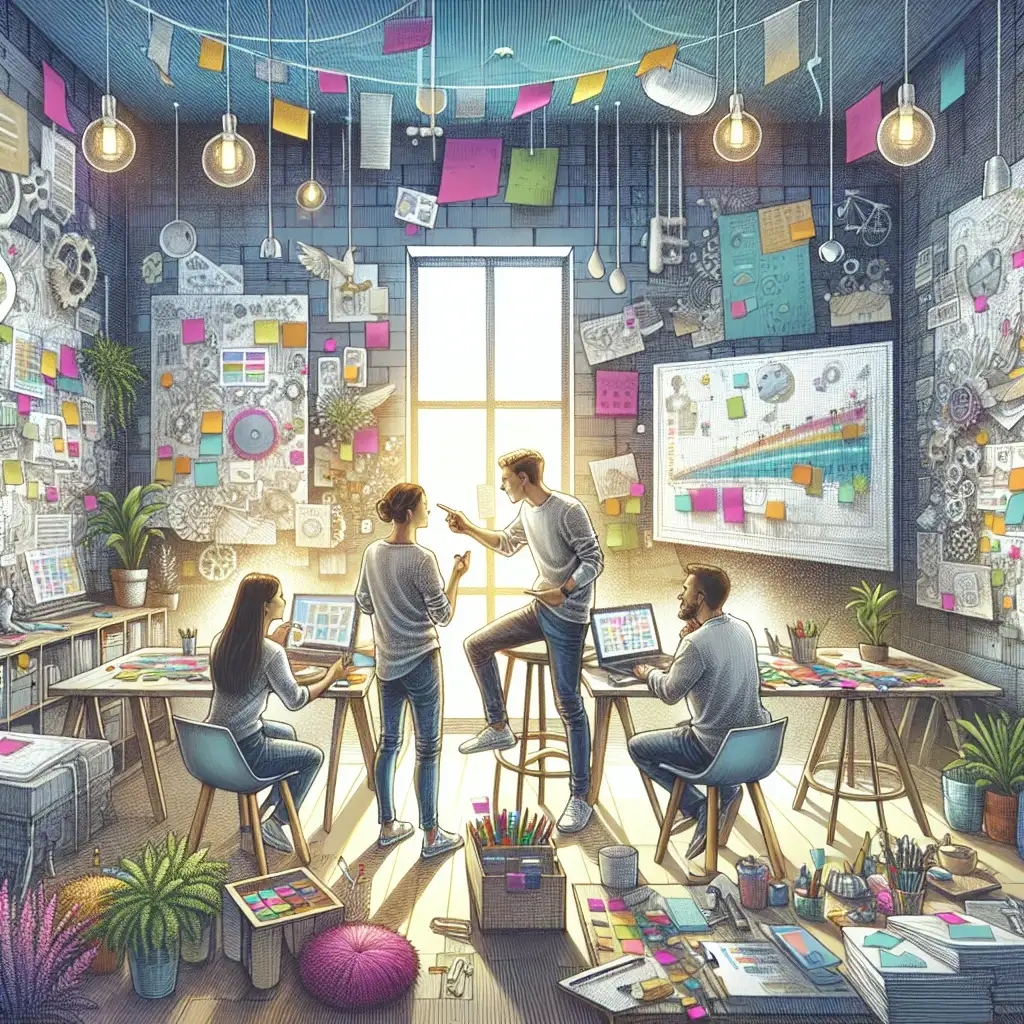Have you ever been part of a team that felt more like a collection of individuals than a cohesive unit? Surprising as it may seem, research shows that the most successful teams operate with a shared creative control, blending diverse talents to achieve innovative solutions. When each member feels empowered to contribute their ideas, the results can be truly astounding.
Learning how to effectively share creative control in team projects is essential for fostering an environment where everyone feels valued. It’s not just about achieving a project goal; it’s about creating a culture of collaboration and trust that encourages risk-taking and experimentation. Imagine a team where every voice is heard, ideas flourish, and creativity knows no bounds.
This article is your guide to cultivating that environment through strategic practices. We’ll explore the importance of clear goals and open communication, dive into nurturing individual strengths, and cover how to balance leadership and collaboration. You’ll discover actionable strategies that not only enhance teamwork but also unleash the full potential of your project. Ready to transform your team’s dynamic? Let’s dive in!

Define the project objectives
Start by gathering your team to discuss what the overall goals of the project are. It's essential that everyone understands what success looks like for this particular endeavor. Make sure the objectives are specific, measurable, achievable, relevant, and time-bound (SMART). This clarity will allow everyone to align their efforts and stay focused.
Clarify everyone's roles
Identifying roles within the team is crucial. Encourage each member to express their strengths and preferences, ensuring everyone feels empowered in their contributions. By explicitly outlining who is responsible for each part of the project, you can avoid confusion and overlap, allowing the team to work harmoniously together.
Establish deadlines and milestones
Set clear deadlines for each phase of the project. Break the work into manageable milestones that will allow the team to celebrate small victories along the way. Having a timeline not only keeps the project on track but also creates accountability among team members. Everyone will know when their input is needed and can prioritize accordingly.
Discuss resource availability
Take stock of the resources available to your team—whether they be tools, materials, or budget. Being upfront about these assets will help everyone stay realistic about what can be achieved. Having open discussions about resources can inspire creativity and collaboration, enabling the team to find innovative solutions within their means.
Document the agreed-upon goals
Ensure that all the goals, roles, deadlines, and resources are documented clearly. This serves as a reference point for the entire team and helps maintain focus throughout the project. Make this document accessible to all team members, and encourage regular check-ins to make sure everyone remains aligned and can adjust as necessary.

Schedule regular check-ins
Make it a routine to hold weekly or bi-weekly meetings. This time can be used to discuss progress, challenges, and new ideas. Consistency builds trust and ensures everyone feels connected and informed about the project's direction. Use these check-ins as a dedicated time for all team members to voice their thoughts and opinions.
Create a safe space for ideas
Foster an environment where all team members feel free to contribute their ideas without fear of criticism. Encourage open dialogue and experimentation. You might set ground rules for discussions that emphasize respect and support, which can help in cultivating this atmosphere. Reassure team members that every idea is valuable; this will encourage creativity and risk-taking.
Use collaborative tools for updates
Implement tools such as Trello, Slack, or Google Docs to streamline communication and project updates. This helps keep everyone on the same page. Choose platforms that encourage collaboration and allow for easy sharing of feedback and resources. Regularly updating these tools can help maintain transparency and keep creative discussions flowing.
Actively listen to team members
Practice active listening by engaging with what your team members are saying. Show that you value their opinions by responding thoughtfully. Ask clarifying questions to ensure understanding and to reveal deeper insights into their ideas. This not only fosters a sense of inclusion but also cultivates a team dynamic where everyone feels acknowledged.
Address misunderstandings immediately
When conflicts or misunderstandings arise, tackle them head-on rather than letting them fester. This can prevent escalation and promotes a healthy team dynamic. Encourage team members to speak up when they feel something is off; make it clear that issues will be resolved respectfully. Taking the time to clarify doubts can enhance communication and strengthen team bonds moving forward.

Recognize individual strengths
Take the time to understand what unique skills each teammate brings to the table. Identifying these strengths allows you to tap into the full potential of your team. Initiate one-on-one conversations or team-building activities to discover hidden talents. This not only shows that you value their abilities but also helps to create a foundation of trust.
Empower teammates to lead initiatives
Encourage your teammates to take ownership of specific projects or tasks. Allowing them to lead fosters accountability and boosts their confidence. By stepping back and allowing others to take charge, you demonstrate your trust in their capabilities. This empowers them to unleash their creativity and innovate.
Celebrate achievements and contributions
Acknowledge and celebrate both individual and team successes, regardless of their size. Public recognition not only motivates the person involved but also inspires others to strive for excellence. Create a culture where achievements are shared openly through team meetings or social platforms. This reinforces teamwork and cultivates enthusiasm for future projects.
Allow room for creative risk
Encourage your team members to share their wildest ideas without fear of judgment. Creating a safe space for risk-taking leads to innovative solutions and fresh perspectives. Highlight that failure is part of the creative process; every great idea often stems from countless iterations. This mindset fosters resilience and encourages out-of-the-box thinking.
Provide constructive feedback
When giving feedback, focus on how it can enhance the work rather than purely pointing out flaws. Use specific examples to illustrate your points and ensure it's an opportunity for growth. Cultivating a feedback loop encourages improvement and shows your commitment to the team’s success. This reinforces trust, as team members feel supported in their development.

Rotate leadership roles
To foster a sense of ownership and engagement, rotate the leadership role among team members. This can be done for each phase of the project or assign it based on specific tasks. By doing so, you allow everyone to bring their unique skills and perspectives to the forefront, enhancing creativity and innovation. This rotation can also help to build empathy among team members, as they learn the challenges and responsibilities associated with leading the team.
Encourage team input in decisions
Create an open environment where team members feel comfortable sharing their ideas and suggestions. Implement brainstorming sessions where every voice is heard. Utilize tools like anonymous feedback forms or dedicated discussion forums to ensure that quieter team members can contribute without feeling overshadowed. When team members feel their input is valued, they are more likely to invest emotionally in the project, leading to higher quality outcomes.
Prioritize consensus over majority rule
To promote harmony and collaboration, strive for consensus when making decisions rather than relying solely on majority votes. This approach encourages deeper discussion and understanding. Facilitate discussions that seek to address all concerns and perspectives, which can lead to more creative and well-rounded solutions. Consensus building fosters a culture of mutual respect and cooperation, making the team more resilient in the face of challenges.
Resolve conflicts collaboratively
Conflict is a natural part of teamwork, but how it's handled can make or break the project. Encourage team members to address conflicts directly and constructively. Facilitate mediation sessions where all parties can express their viewpoints and work towards a solution together. This approach can help transform conflicts into opportunities for growth. Collaborative conflict resolution strengthens team dynamics and deepens relationships, leading to a more cohesive and creative group.
Adapt leadership style as needed
Recognize that one leadership style does not fit all situations. Be flexible and willing to adapt your approach based on the team's needs and the project's demands. Engage in regular check-ins to assess how the team is feeling about the current leadership style and make adjustments as necessary. By showing adaptability, you not only model important skills but also empower your team to thrive in diverse circumstances, ultimately fostering a more creative and effective collaborative environment.

Choose a suitable project management tool
Selecting the right project management tool can set the tone for collaboration. Research various options like Trello, Asana, or Monday.com to find one that fits your team's needs. Consider your team's workflow and the features that will enhance it—whether it’s task assignments, timelines, or discussion boards. Don’t hesitate to involve your team in making this choice!
Share access to all relevant resources
Ensure that everyone on the team has access to necessary resources such as documents, images, and research materials. Use cloud storage solutions like Google Drive or Dropbox for easy sharing. By centralizing your resources, you minimize confusion and promote transparency. Make it a habit to organize and update these resources regularly so everyone can find what they need.
Regularly update project documentation
Keep your project documentation current to maintain clarity throughout the project’s lifecycle. Choose a template or framework that everyone can use for consistency. Encourage team members to regularly contribute updates or notes to the documentation. This ensures that everyone is on the same page and decreases the likelihood of miscommunication.
Implement version control for changes
Utilizing version control tools, like GitHub or Bitbucket, can greatly enhance your team's ability to collaborate on documents or code. This way, everyone can make changes without overwriting someone else's work. Ensure that your team understands how to use these platforms effectively. Providing a brief training session can mitigate errors and make everyone feel confident in contributing.
Evaluate the effectiveness of tools used
Periodically assess the tools you've implemented to determine whether they're meeting your collaboration needs. Gather feedback from your team about what works and what doesn’t. Don't be afraid to pivot if necessary. Sometimes, adapting your tools can lead to significant improvements in creativity and productivity.
In conclusion, sharing creative control in team projects can redefine the way your group collaborates and innovates. It’s time to embrace this approach and see the positive impact it can have on your projects.
Start by fostering open communication and setting clear goals. Encourage everyone to contribute their ideas, and make sure that all team members understand their roles within the process. This clarity will inspire confidence and drive engagement.
Recognizing individual strengths and allowing team members to lead not only builds trust but also empowers creativity. Celebrate accomplishments together, big or small, to cultivate an atmosphere where success is shared, and enthusiasm flourishes.
As you navigate the challenges of collaboration, remember that conflicts are part of the journey. Address them directly and constructively, turning disagreements into opportunities for deeper understanding and innovation.
Finally, utilize collaborative tools that match your team’s needs, ensuring everyone is onboard with using them effectively. Regular check-ins will keep your project moving forward and maintain that essential sense of connection.
Don’t hesitate to implement these strategies today! Your team has the potential to thrive, create, and succeed together in ways you might have never imagined. Get excited about the creative possibilities that await!